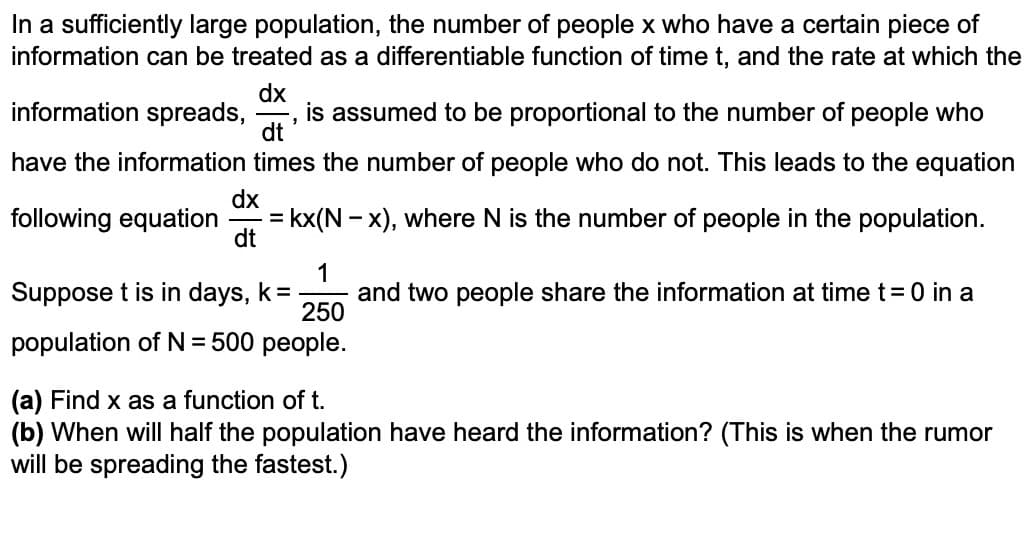In a sufficiently large population, the number of people x who have a certain piece of information can be treated as a differentiable function of time t, and the rate at which th dx information spreads, is assumed to be proportional to the number of people who 1 dt have the information times the number of people who do not. This leads to the equation following equation dx - = kx(N − x), where N is the number of people in the population. dt 1 Suppose t is in days, k = and two people share the information at time t = 0 in a 250 population of N = 500 people. (a) Find x as a function of t. (b) When will half the population have heard the information? (This is when the rumor will be spreading the fastest.)
In a sufficiently large population, the number of people x who have a certain piece of information can be treated as a differentiable function of time t, and the rate at which th dx information spreads, is assumed to be proportional to the number of people who 1 dt have the information times the number of people who do not. This leads to the equation following equation dx - = kx(N − x), where N is the number of people in the population. dt 1 Suppose t is in days, k = and two people share the information at time t = 0 in a 250 population of N = 500 people. (a) Find x as a function of t. (b) When will half the population have heard the information? (This is when the rumor will be spreading the fastest.)
Functions and Change: A Modeling Approach to College Algebra (MindTap Course List)
6th Edition
ISBN:9781337111348
Author:Bruce Crauder, Benny Evans, Alan Noell
Publisher:Bruce Crauder, Benny Evans, Alan Noell
Chapter2: Graphical And Tabular Analysis
Section2.1: Tables And Trends
Problem 1TU: If a coffee filter is dropped, its velocity after t seconds is given by v(t)=4(10.0003t) feet per...
Related questions
Question

Transcribed Image Text:In a sufficiently large population, the number of people x who have a certain piece of
information can be treated as a differentiable function of time t, and the rate at which the
dx
information spreads, is assumed to be proportional to the number of people who
3
dt
have the information times the number of people who do not. This leads to the equation
dx
following equation = kx(N − x), where N is the number of people in the population.
dt
1
Suppose t is in days, k = and two people share the information at time t = 0 in a
250
population of N = 500 people.
(a) Find x as a function of t.
(b) When will half the population have heard the information? (This is when the rumor
will be spreading the fastest.)
Expert Solution
This question has been solved!
Explore an expertly crafted, step-by-step solution for a thorough understanding of key concepts.
This is a popular solution!
Trending now
This is a popular solution!
Step by step
Solved in 7 steps with 7 images

Recommended textbooks for you

Functions and Change: A Modeling Approach to Coll…
Algebra
ISBN:
9781337111348
Author:
Bruce Crauder, Benny Evans, Alan Noell
Publisher:
Cengage Learning

Algebra and Trigonometry (MindTap Course List)
Algebra
ISBN:
9781305071742
Author:
James Stewart, Lothar Redlin, Saleem Watson
Publisher:
Cengage Learning

Trigonometry (MindTap Course List)
Trigonometry
ISBN:
9781337278461
Author:
Ron Larson
Publisher:
Cengage Learning

Functions and Change: A Modeling Approach to Coll…
Algebra
ISBN:
9781337111348
Author:
Bruce Crauder, Benny Evans, Alan Noell
Publisher:
Cengage Learning

Algebra and Trigonometry (MindTap Course List)
Algebra
ISBN:
9781305071742
Author:
James Stewart, Lothar Redlin, Saleem Watson
Publisher:
Cengage Learning

Trigonometry (MindTap Course List)
Trigonometry
ISBN:
9781337278461
Author:
Ron Larson
Publisher:
Cengage Learning
